
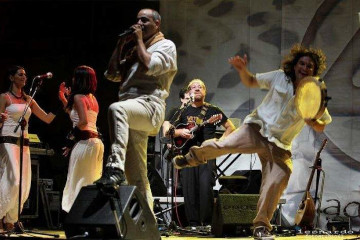
The music of Calabria is part of the Italian musical tradition. Like other regions in southern Italy, Calabria for many centuries was an integral part of the kingdom of Naples, and, as with other regions, the musical life tended to be overshadowed by the important activities in the capital city to the north—the conservatories there, the composers, the vast amount of music performed in churches (see also Music of Naples). Yet, modern Calabria has developed a vibrant musical life based on its history and, as well, a dedication to building new musical and theatrical facilities, many of which are of the type termed polivalenti in Italian—that is, multi-purpose.
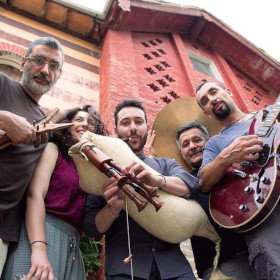
The rural Calabrian folk tradition is most closely associated with the zampogna, the Italian bagpipe, which is found across Italy but is an especially important part of the Calabrian tradition. Calabria is home to at least five different kinds of zampogna. This tradition has lately been recorded and adapted by the group Re Niliu. There is also an ancient Lira (violin) tradition, pipita and tambourine.
The chitarra battente (in Italian "strumming guitar", however "battente" literally means "beating" related to the fact that this guitar thumps the rhythm of the music) is a musical instrument, a chordophone of the guitar family. It is similar to the 5-course baroque guitar, but larger and typically strung with five double strings, traditionally made of brass, but currently - steel. Nowadays it is typically used by folk musicians, mainly in the southern Italian regions of Calabria, Apulia, Basilicata, and Campania, as well as in other areas of southern Italy; in past centuries the instrument was found in most of central and southern Italy.
It is considered a folk instrument, though it has its origins in the Italian court music in the early Baroque era. Musicologists refer to the "historical" as well as the "folk" chitarra battente. There are many extant historical 17th century instruments in museums. Though now associated with Southern Italy, the chitarra battente has been built and played as far north as Ponte Caffaro in Lombardy until the turn of the 20th century.
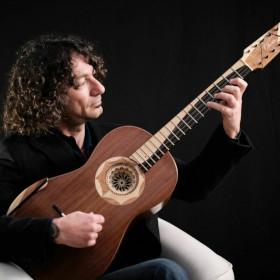
The chitarra battente comes in three sizes. The medium and large instruments are the most common. The instrument may have five or four courses of strings. These courses are typically double or triple, a“course” being a group of 2 or 3 strings plucked as a single unit. Thus chitarra battente is typically a five or four-course instrument.
There is great variation in the size of the bouts (the rounded “hourglass” curves of the body of the instrument), kinds of wood, shape of the back, decorations, number of frets, etc. The strings are tuned in what is called a “re-entrant” system; that is, unlike a modern classical guitar, the lower strings may be tuned to higher pitches.
The instrument is played without a plectrum, and the fingers achieve a wide range of effects through plucking, strumming, beating the strings or the sound board, etc. The chitarra battente is typically used to accompany singing or dancing and can be played in an ensemble or as a solo instrument. The most important center of production is in Bisignano in the province of Cosenza. Traditionally the instrument has been made locally in the region from which its characteristics derive, often being constructed by non-professional craftsmen or simple carpenters.
From the first to the fifth courses of strings, the tuning is usually: E (Mi), B (Si), G (Sol), D (Re), A (La), like one of the three tunings of the baroque guitar.
Notable virtuosos on chitarra battente are Marcello Vitale, Alessandro Santacaterina and Francesco Loccisano.
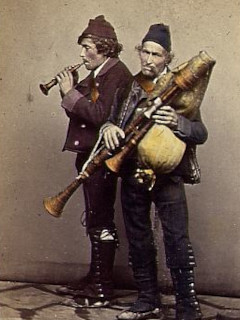
Zampogna (UK: /zæmˈpɒnjə/, US: /zæmˈpoʊnjə, (t)sɑːmˈ-/, Italian: [dzamˈpoɲɲa]) is a generic term for a number of Italian double chantered pipes that can be found as far north as the southern part of the Marche, throughout areas in Abruzzo, Latium, Molise, Basilicata, Campania, Calabria, and Sicily. The tradition is now mostly associated with Christmas, and the most famous Italian carol, "Tu scendi dalle stelle" (You Come Down From the Stars) is derived from traditional zampogna music. However, there is an ongoing resurgence of the instrument in secular use seen with the increasing number of folk music festivals and folk music ensembles.
All chanters and drones are fixed into a single round stock that the bag is attached to. Each chanter is tuned differently, according to the tradition it represents, and there are dozens. Typically, the double-reeded versions (Marche, Abruzzo, Latium, Campania, southern Basilicata and parts of Sicily and southern Calabria) will have a soprano chanter on the right and a bass chanter on the left (called, respectively, ritta and manga—meaning 'right' and 'left'—in the tradition of Southern Latium) with an alto drone (bordone being the generic name); but as many as three drones, the other tuned above and below the basic chord can be used, or, in the case of the Marches tradition, no drones at all. The single reed versions consist of the surdullina types of the Province of Cosenza and Catanzaro, and the ciaramella or ciaramedda of Messina and Catania in Sicily, as well as in Southern Calabria. The surdullina is a very short chantered version of the instrument that is used to play tarantellas primarily, while the ciaramedda can play all of the traditional regional melodies the other types can.
The traditional reeds are made from stalks of the Giant Reed Arundo donax, called "canna marina" in Italian. The double reed versions may also be made from plastic. The single reeds are made from a single section of the cane.
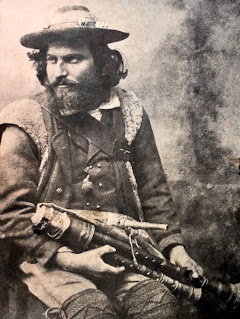
Traditionally the bags are made from goat hides that are removed from the slaughtered animal in one piece, cured, turned inside out, then tied off just in front of the rear legs, one of the front legs serving to house the blow pipe with its simple leather valve (soffietto), and the other tied off. The typical round stock into which both chanters and drones are fixed goes into the neck of the skin. The hair is left on, and is contained in the inside of the bag (otre). Today, however, some pipers are substituting the traditional goat and sheep hide bags with a rubber inner tube or wintex which is covered with an artificial fleece. This practice of using the synthetic bag is particularly popular among the pipers from Scapoli in the Molise region, and those of Atina in Latium.
The double reeded version of the zampogna is generally played with the piffero (called biffera in Lazio, or ciaramella or pipita in other regions; a shawm, or folk oboe), which plays the melody and the zampogna provides chord changes, "vamping" or rhythmic harmony figures or a bass line and a soprano harmony as accompaniment. This double reed tradition would include Central Italy (Latium, southern Abruzzo and Molise), that of southern Basilicata (Pollino) and nearby areas of Calabria, and some areas of Sicily (Syracuse, Palermo). Single reed versions are played solo in the Calabrian tradition of the surdullina (Cosenza), and a version with a plugged chanter called the surdullina albanese, and the Sicilian ciaramedda or ciaramella (Catania, Messina, and Reggio Calabria). The chanters and drones vary, according to the tradition, from a few inches long (surdullina) to nearly two meters in length, such as used in the cathedral of Monreale (Palermo) and nearly every size in between. The pipes are related to the Sardinian launeddas, a single reed "triple clarinet" comprising two chanters and a drone and played in the mouth by circular breathing.
The word zampogna is etymologically related to the Greek symphōnia (συμφωνία), meaning "concord or unison of sound" (from σῠν- syn-, "with, together" + φωνή phōnḗ, "sound") and applied later to a type of bagpipe. It cognates to tsampouna, the word for the Greek island bagpipe (itself a reborrowing of zampogna), Romanian cimpoi, which means "symphony" or "many sounds played together", and Georgian čiboni.
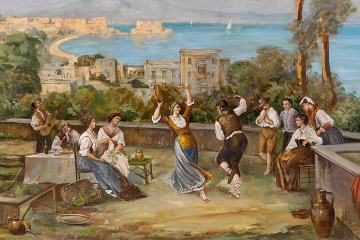
Tarantella (Italian pronunciation: [taranˈtɛlla]) is a group of various folk dances characterized by a fast upbeat tempo, usually in 6
8 time (sometimes 12
8 or 4
4), accompanied by tambourines.[2] It is among the most recognized forms of traditional southern Italian music. The specific dance-name varies with every region, for instance tammurriata in Campania, pizzica in the Salento region, and Sonu a ballu in Calabria. Tarantella is popular in Southern Italy and Argentina. The term may appear as tarantello in a linguistically masculine construction.

In the Italian province of Taranto, Apulia, the bite of a locally common type of wolf spider, named "tarantula" after the region, was popularly believed to be highly venomous and to lead to a hysterical condition known as tarantism. This became known as the "tarantella". R. Lowe Thompson proposed that the dance is a survival from a "Dianic or Dionysiac cult", driven underground. John Compton later proposed that the Roman Senate had suppressed these ancient Bacchanalian rites. In 186 BC the tarantella went underground, reappearing under the guise of emergency therapy for bite victims.
The stately courtship tarantella danced by a couple or couples, short in duration, is graceful and elegant and features characteristic music. On the other hand, the supposedly curative or symptomatic tarantella was danced solo by a victim of a Lycosa tarantula spider bite (not to be confused with what is commonly known as a tarantula today); it was agitated in character, lasted for hours or even up to days, and featured characteristic music. However, other forms of the dance were and still are dances of couples usually either mimicking courtship or a sword fight. The confusion appears to derive from the fact that the spiders, the condition, its sufferers (tarantolati), and the dances all have names similar to the city of Taranto.
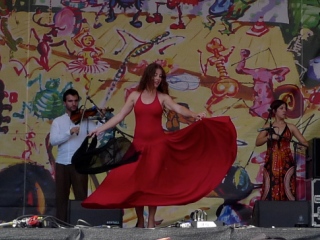
The dance originated in the Apulia region, and spread throughout the Kingdom of the Two Sicilies. The Neapolitan tarantella is a courtship dance performed by couples whose "rhythms, melodies, gestures, and accompanying songs are quite distinct" featuring faster more cheerful music. Its origins may further lie in "a fifteenth-century fusion between the Spanish Fandango and the Moresque ballo di sfessartia." The "magico-religious" tarantella is a solo dance performed supposedly to cure through perspiration the delirium and contortions attributed to the bite of a spider at harvest (summer) time. The dance was later applied as a supposed cure for the behavior of neurotic women (Carnevaletto delle donne).

There are several traditional tarantella groups: Cantori di Carpino, Officina Zoé, Uccio Aloisi gruppu, Canzoniere Grecanico Salentino, Selva Cupina, I Tamburellisti di Torrepaduli.
The tarantella is most frequently played with a mandolin, a guitar, an accordion and tambourines. Flute, fiddle, trumpet and clarinet are also used.
The tarantella is a dance in which the dancer and the drum player constantly try to upstage each other by playing faster or dancing longer than the other, subsequently tiring one person out first.
Tarantism, as a ritual, is supposed to have roots in the ancient myths. Reportedly, victims who had collapsed or were convulsing would begin to dance with appropriate music and be revived as if a tarantula had bitten them. The music used to treat dancing mania appears to be similar to that used in the case of tarantism though little is known about either. Justus Hecker (1795–1850), describes in his work Epidemics of the Middle Ages:
A convulsion infuriated the human frame [...]. Entire communities of people would join hands, dance, leap, scream, and shake for hours [...]. Music appeared to be the only means of combating the strange epidemic [...] lively, shrill tunes, played on trumpets and fifes, excited the dancers; soft, calm harmonies, graduated from fast to slow, high to low, prove efficacious for the cure.
The music used against spider bites featured drums and clarinets, was matched to the pace of the victim, and is only weakly connected to its later depiction in the tarantellas of Chopin, Liszt, Rossini, and Heller.
While most serious proponents speculated as to the direct physical benefits of the dancing rather than the power of the music, a mid-18th century medical textbook gets the prevailing story backwards, describing that tarantulas will be compelled to dance by violin music. It was thought that the Lycosa tarantula wolf spider had lent the name "tarantula" to an unrelated family of spiders, having been the species associated with Taranto, but since L. tarantula is not inherently deadly, the highly venomous Mediterranean black widow, Latrodectus tredecimguttatus, may have been the species originally associated with Taranto's manual grain harvest.
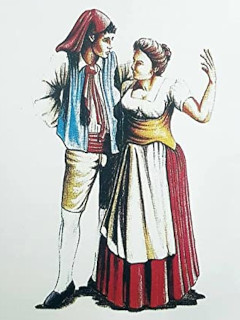
Calabrian Tarantella (in italian: Tarantella Calabrese or "Sonu a ballu": playing for dancing) is a generic term to include different musical-dancing expressions spread in Calabrian peninsula and different from other southern Italian dances called simply Tarantella. It is played and danced during religious festivals and other social occasions. In recent times the tradition has been revived as new groups are taking an interest in instruments which had been falling into obscurity; they played "ad usu anticu" (in the old/traditional way) or they modernised the sound adding a bassline or new sounds.
Musical instruments of Calabrian Tarantella are: zampogna, substituted often by organetto, with tamburello, in some areas was used Zampogna with Pipita and Fischiotta, while in Locride e Monte Poro was used calabrian lira. Rhythm is based on terzine with time in 12/8 and sometimes in 6/8.
Although there is homogeneity in Tarantella played and danced in all Calabria, there are some geographical differences: there is libera in east catanzarese, sonu a ballu in Aspromonte and Zumparieddu in Sila and Viddanedda in Reggio Calabria and style differences: fimminina (female style), masculina (male style), libera.
Tarantella calabrese is a man-women couple dance, but it could be also man-man and woman-woman, in a circular space made of moving people named "rota" (wheel). "U mastru i ballu" (Master of dance) decide the order of the dancers inside rota managed turns. Players outside rota follow and feel dancers and change music rhythm. In the past, during dancing, the people created a unique rota in the square where they danced.
Calabria was once the "Reign of Italos" - a legendary king of the Oenotrians, an ancient people of Greek origin who inhabited this region of southern Italy. The Greeks eventually used the name Italia to indicate the rest of the country. CalabriaSona is a cultural circuit, and an independently run boutique and full-service music agency specialised in world/folk music from Calabria.
Our catalogue is unique and includes most of the artists/bands who made, and are still making, a mark in the panorama of Calabria world/folk music. The music of Calabria has its own identity, diversity, and charm. It also has its talents and a strong audience - both locally and in various parts of the world, especially Canada, and northern/southern America where the diaspora from Calabria is present.
At Calabriasona, we believe that music and culture are strong drivers for tourism and sustainable local development, especially in a region with a rich and diverse historical and natural heritage. Since 2012, our agency is assembling an eclectic roster of artists who, through research and innovation, put a new light on the cultural and musical heritage of the region – which also includes the true tarantella and the music of the old Calabrian Greek and Arbereshe minorities.
We handle all aspects of the music production and marketing cycle, as well as the live performances of our artists by working and collaborating with local, national, and international partners (festivals, venues, promoters, presenters, media professionals, radio, and TV broadcasters, etc.) while curating about 15 festivals, and successful events, tours, and career opportunities. We strive for long-term working relationships and are always open to new collaborations that can help boost our artists’ careers.
We present you some artists/bands available for touring in Europe, as well as exclusive news about our new productions and special events.
Loccisano-De Carolis Guitar Duo: The Unique Sound and Thrill of the Chitarra Battente
The collaboration between the two guitarists from Southern Italy - Francesco Loccisano and Marcello De Carolis has no real beginning. It all started with their passion for guitar playing and their interest in a traditional folk guitar called “Chitarra Battente”.
"When we started with the instrument, which is typical of the musical traditions of the southern part of Italy, it seemed impossible to make use of it for soli and melodies. But after various experiments, a new sound took shape. It was so unique that we went for it. We eventually created a method ("La Chitarra Battente - Metodo Base”) published by fingerpicking.net, and worked on a repertoire of our own compositions which is included in the album “Venti” that was released in 2020.”
Francesco Loccisano is a classical guitar player from Calabria who developed a passion for this almost forgotten instrument from the rich and diverse musical heritage of his region. While creating its own signature on the instrument and releasing his first two albums, he was invited in 2015 to join the Taranta Power Band of Italian world music legend Eugenio Bennato. He also appears on the stage of the likes of Vinicio Capossela and Gianna Nannini.
Classical guitarist Marcello De Carolis founded the duo "Cordaminazioni" in 2015 with whom he released his first album. From his firendship with Loccisano, healso started to develop his own style on the "chitarra Battente".
The duo, which has performed mostly in Italy in theaters, conservatories, and festivals auditoriums, and summer festivals, also started recently to play internationally.
Parafonè: Trad-Innovation and Feel-Good Music Made In Calabria
The ethno-grove Calabrian band Parafonè has been in business for 15 years. They are a good example on how one find inspiration in the rich local cultural heritage to innovate and put forward the musical traditions of an area that, in the middle of the Mediterranean and between two seas, has always been a place of virtuous contamination and the cradle of Tarantella– from the times of the ancient Magna Grecia to modern days. The wealth of local traditional instruments fits perfectly in a bed of bass/drums/guitars, and the exhilarating drive of the music is as good as anything coming from Africa (or the neighboring Puglia). This is a feel-good and festival band you want to present to your audience.
Folkatomik: Electronically Folk
Folkatomik is an Italian quartet with several identities.
Guitarist, DJ and producer, Daniele Li Bassi has shared the stages of Steve Winwood, Whitney Houston, Eugenio Finardi, Max Gazzè, Bandabardò, and many others Italian and international artists. He has been signed with various labels including Emi, Warner Chappell, Universal, Diy, and RaiTrade.
Franco Montanaro is a singer, drummer, and percussionist with an extensive CV on music from Southern Italy and North Africa. He has performed in two editions of the major Italian music festival “La Notte della Taranta”.
Multi-instrumentalist, Oreste Forestieri plays flutes, reed instruments, frame drums and plectrum. He worked as sidemanin for many Italian artists and has touredextensively in Europe, The Mediterranean, and Latin America.
Valeria Quarta is an experienced singer (opera, jazz, soul, blues) who specialiesed in popular music from Puglia. She has been working for years as the lead singer of the "Valeria Quarta Pproject", and as part of the "Three Sisters" female vocal trio.
The quartet blends electronic avant-garde sounds with elements of traditional music from the southern Italy and the Mediterranean. The result is an original live performance where traditional instruments and synthesizers & electronics meet on stage to produce a glocal energy feel that makes you dance and reconnect with the deep and the ancient.
A Special Project: Calabria Orchestra
The idea of the orchestra came from Checco Pallone, an artist who has released various albums over the years. He wanted to set up an orchestra made of representatives of the various bands that populate the musical panorama of the region. Calabria Sona released the album "Calabria Orchestra Live" in 2021 and presented their live performance at events in Calabria and Italy.
Calabria Orchestra's conductor, Checco Pallone, released his new album " Fiore Selvatico" on May 21 at Torino International Book Fair 2022.
We'll make a short focus on Tarantella, of which Calabria is the cradle - as well as on some of its most representative artists and curators.
CALABRIAN TARANTELLA By Eric E. van Monckhoven
The music of Calabria is part of the Italian musical tradition. Like other regions of southern Italy, Calabria has a rich and diverse heritage of cultural traditions, including, for instance, the Calabrian Tarantella. Tarantella, pizzica pizzica, tammuriata are a large family of traditional dances. In some areas, they are associated with the ancient ritual against the bite of the tarantula, the poisonous spider.
Nobody knows exactly the Calabrian Tarantella’s origin, but the dance was transmitted orally from the most ancient times – supposedly when Calabria was part of the Magna Grecia and the home of many Greek settlers. Calabria is still hosting today a strong Greek ethnic minority in the Reggio Calabria and Locride coastal areas.
Whether formally or informally, whenever there is an event, small or big, that brings together two or three seasoned musicians with tambourines and concertina, a crowd will invariably gather and begin to dance with the sort of precise and energy-saving movements that characterize the Calabrian Tarantella dance steps. As a passerby, you first hear the rhythmic pulses and accompanying jangle of the tambourine, then the bouncing, reedy tones squeezed out of the concertina. Upon turning the corner, you see the little crowd, swaying and tapping to a snappy folk tune. An impromptu assembly invites audience participation.
A dance master (mastru d’abballu) is chosen and takes his position at the center of the circle composed by the assembly who is clapping hands. Then, he heads to the audience and chooses a partner, inviting her (or him) with a slight bow as a sign of respect. After some rounds, he invites other dancers to join in. The dance is strictly codified and limits physical contact. A dancing party can last long, with haunting and enthralling rhythms – also thanks to the abundance of wine.
Musical instruments of Calabrian Tarantella are: zampogna (bagpipe), substituted often by organetto (concertina/button accordion), with tamburello (tambourine). Additional instruments are the Calabrian lira, the “chitarra battente” (strummed guitar), “Pipita” and “Fischiotta” (shepherd flutes), depending on the area. Rhythm is based on terzine (1-2-3) with time in 12/8 and sometimes in 6/8.
Ciccio Nucera: The King of Calabrian Tarantella
"Teaching is easy. Transmitting love, passion, and ethical values is a hard job. I could not be the spoke person of my cultural heritage without living it actively."
Ciccio Nucera is the true king of Calabrian Tarantella, and an institution locally. For over 20 years, he has been performing, promoting, and teaching tarantella, tambourine, and accordion to revive the sense of community in the Greek area of Calabria. An active member of the cultural association Cumelca, he contributes to Calabria's Greek minority language, traditions, and customs safeguard and protection. With a strong sense of belonging to the area where he is born, Ciccio is on a mission to transmit his cultural heritage to the new generation. His concerts are among the most popular in Calabria. They attract people of all ages from any corner of the region, including the elderly and families with kids. He has directed various festivals and is at the origin of the Caulonia Taranta Power festival's success. The motto of the popular movement for the practice of traditional and local folk and dance music he created is "Calabrian tarantella creates addiction." His collaborations include the likes of Carlos Nunes, Eugenio Bennato, Phaleg, Toni Esposito, Ettore Castagna, Antonio Grosso, and many other artists and musicians.
Le Muse del Mediterraneo & Antonio Grosso
Le Muse del Mediterraneo's marriage of folk music from Calabria and Salento has been rapturously received in southern Italy, Europe, Australia, and Canada. Its five members are united by a love of traditional music and dance, and a commitment to creating new music inspired by Calabria and the Mediterranean. They blend accordion, guitar, and a range of traditional musical instruments, tarantella and vocals with breathtaking vitality. Their brew of boundless energy and unmistakable joie de vivre has won them a fair following that we hope can grow up over the years.
Antonio Grosso is a master button accordion (organetto) player, teacher and researcher. He regularly joins the band on stage
Photo Credits:
(1) Calabria Orchestra,
(2) Quartaumentata,
(3) CalabriaSona,
(4) Re Niliu,
(5)-(6) Marcello De Carolis/Francesco Loccisano,
(7) Parafonè,
(8)-(9) Zampogna,
(10) Folkatomik,
(11)-(12) Tarantella,
(13) Checco Pallone,
(14) Canzoniere Grecanico Salentino,
(15) Officina Zoé,
(16) Tarantella Calabrese,
(17) Ciccio Nucera,
(18) Le Muse del Mediterraneo,
(19) Antonio Grosso
(unknown/website).